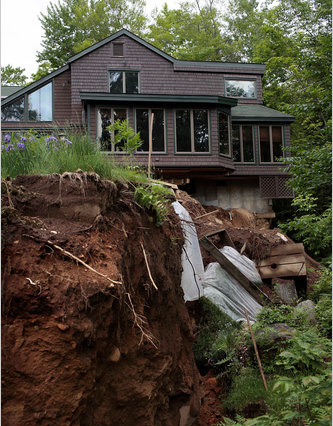
10/28/2011
When homeowners in the Adirondack region noticed tilting trees outside their windows and large cracks in their driveways in May, they relied on Andrew Kozlowski ’95, a high-ranking geologist at the State Museum and a SUNY Cortland graduate, for answers. He ended up leading the research team on what turned out to be the largest landslide in New York state’s modern history.
Kozlowski, who majored in geology at SUNY Cortland, will present his research on the landslide to the College at 7 p.m. on Thursday, Nov. 3, in Sperry Center, Room 204. His lecture, titled “The Keene Valley Landslide and Landslide Hazards in New York,” is free and open to the public. SUNY Cortland’s Geology Club is sponsoring the talk.
“This doesn’t happen in New York State very often,” said Robert Darling, the chair of the SUNY Cortland Geology Department. “But when it does occur, you need to send in a team who can better understand it and assess landslide hazards.”
Kozlowski headed to Porter Mountain in the Adirondacks in early May and discovered earth crumbling around the edges of houses. A handful of homeowners who lived in the hamlet of Keene Valley were left displaced. The landslide was moving at least one or two feet per day, which is rapid in geological terms.
Kozlowski concluded that the slide occurred when the ground became oversaturated with water. The combination of rapidly melting snow and heavy spring rains proved disastrous for homeowners. The earth slid up to 30 feet in some places by early June and the sliding continued through the summer.
“It happened in May and it kept slowly moving downhill,” said Darling, who visited the landslide site in July.
One house required at least $150,000 in repairs. None of the destruction was covered by homeowner’s insurance.
Kozlowski, who also serves as director of the state’s Geological Mapping Program, has been studying the land shift as the lead scientist on the project for the last five months. He measured movement distances daily and worked through setbacks such as the rainfall that came with Hurricane Irene in September.
Kozlowski mostly will speak about what happened in Keene Valley during his Nov. 3 talk and he also will touch on other landslide hazards in New York and how to assess them.
Darling recalled the 1993 landslide that occurred in a valley in Tully, N.Y, just north of Cortland. That year, more than 40 inches of snow fell in the spring. When the snow melted, it completely saturated the ground and triggered a landslide.
By comparison, the Tully landslide affected 30 to 40 acres of land; the one that Kozlowski will talk about impacted 82 acres of earth.
“This stuff is interesting scientifically but it’s also interesting on a personal level,” Darling said. “Anytime something like this affects people, it generates a lot of interest.”